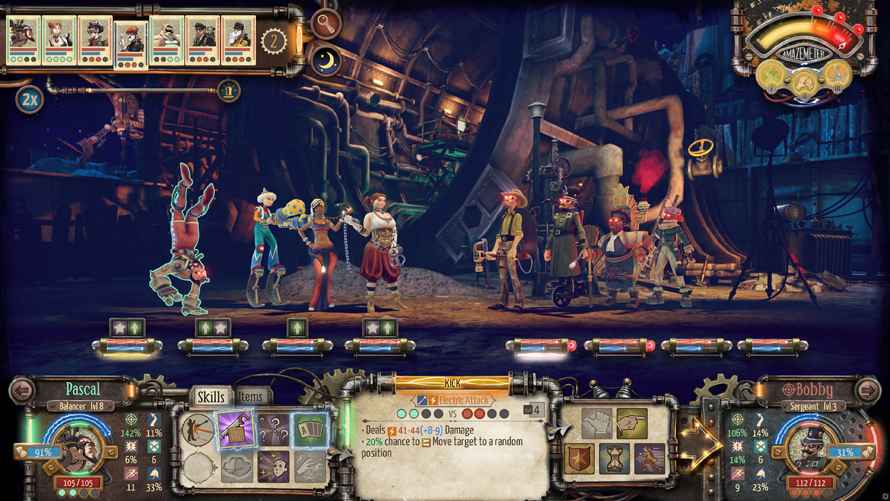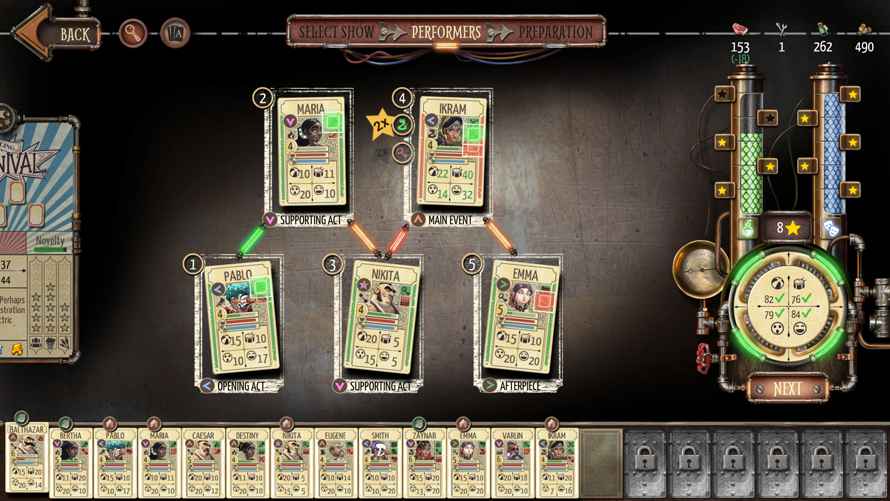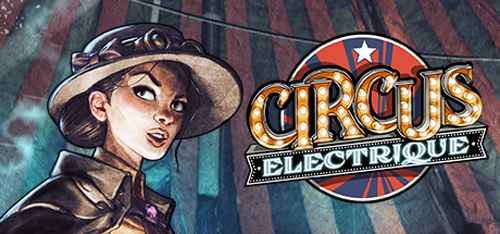Circus Electrique Review
There’s niche in popular culture where steampunk never died, and I’m glad. After being the new hotness for writers, directors, and cosplayers, the flame of steampunk sort of winked out. I never really understood why. Neither did pinball wizards Zen Studios, who have just released Circus Electrique, a turn-based battler in the vein of Darkest Dungeon. If nothing else, it makes me happy to steam-powered machines the focus of a game again.
Lots of Moving Parts
Circus Electrique can be sliced and diced into several interconnected mechanics. Most obviously, there are the turn-based team battles, pitting four circus performers against steampunk-adjacent enemies. Then there is circus village, the usual expandable hub area where you rest performers, add acts, craft consumables and more. Because you manage a circus, there are performances in which you create synergies of acts for stars and cash. Finally, there’s the narrative behind it all.
In most games, one of these mechanics would dominate gameplay. In Circus Electrique, they’re all equally important. Circus Electrique is as much an economic sim as it is a turn-based RPG. Players into complexity and depth will love it. There are stats upon stats to manage and consider, and every battle is a high-wire act. See how I used a circus metaphor there?
What the Hell Happened in London?
Circus Electrique takes place in an alternate history London, where steam and electric power coexist. You play as Amelia, an investigative reporter trying to understand why the ever-proper citizens of Victorian London have transformed into killers. You turn to your uncle for assistance. He just happens to run the Circus Electrique. You basically take over management of the circus, allowing you to recruit and manage a cast of talented performers to battle the forces of evil. Oh, and you have a pet lion, too.

By far, the most delightful and inventive aspect of Circus Electrique is the eccentric cast of characters you recruit and enemies you fight. It’s kind of amazing no one has thought of this before. What could be better than controlling a team of strongmen, clowns, dancing mechanical bears, fire-eaters and acrobats? Or fighting a squad of face-slapping mimes? Of course, under the hood, you’re really dealing with pretty standard classes like tanks, healers, mages, and rogues. In Circus Electrique, the steampunk and circus veneer does an excellent job of making traditional ideas seem brand new.
In large part, this comes from the art, animation, and audio. Each performer and enemy has a range of very well-done resting and battle animations. There’s probably no way that, over time, these animations don’t become a bit overfamiliar. But it’s hard to overstate how amusing and inventive the characters are. The narrative is told via a series of static but fully voiced images. The writing and acting are both excellent.
Here’s Where Things Get Complicated
One of the first things you’ll notice, aside from the art, is that the performers have a lot of stats to track. Just to list a few, there are nine attributes, plus six active skills, passive skills and twenty possible status effects that impact a character’s performance. There are State of Mind stats, a Bobbery meter, something called the Amazemeter and, most critically, the amount of Devotion. Devotion is an incredibly important mechanic in Circus Electrique. It impacts the effectiveness of actions, the performer’s state of mind during combat, and even how acts work together in the shows.

On top of all that, position in the combat turn order makes a huge difference. Many skills depend on a character being in a specific position relative to the enemies. This is not a new mechanic for the genre, but yet another gear in an already complex clockwork. I can see the density of all this being incredibly appealing to some players, while others will be overwhelmed. And combat is only one of Circus Electrique’s mechanics.
Under the Big Top
One aspect of Circus Electrique that’s relatively straightforward is the overworld map. It consists of interlaced paths through five sprawling London districts. Although the general progression is linear and tied to narrative, the paths branch off at many places. Like other, similar games, players will have the choice of — for example — a combat encounter, a treasure chest, or a mysterious unknown stop. Some paths unlock new paths or special rewards.
As players level up, they have access to new structures in the hub area and better performers that arrive on the train. Resting performers restores health and devotion but takes them out of rotation. There is a shop that allows the player to craft consumables. And then, there’s the circus tent under which performances take place.
Performances in Circus Electrique feel a little like card battles. Instead of clashing, however, the idea is to assemble a show out of the stable of performers. Shows have a minimum of three acts, like an opener, a support act and a main attraction. Performers have a long list of stats and preferences that need to be managed. Some prefer to be openers, and others are divas and have to be the main attraction. Set up the shows correctly, with everyone in their happy place, and you earn stars, devotion, and cash. Following the show, you’ll get to see a “review” in the newspaper.

Dizzying Depth
Circus Electrique has a unique vibe, inventive art, and a thoroughly detailed devotion to its steampunk setting. For patient gamers with a love for stats and carefully managed decisions, the engaging combat will be icing on the cake. For some players, Circus Electrique might feel overwhelming, with one or two (or more) mechanics too many. There can be a lot of information on screen, and even more behind the scenes. The presentation is generally fantastic, but players used to simpler games might be surprised at how much work goes into running a circus.
***PC code provided by the publisher***
The Good
- Great art and atmosphere
- Fun story and characters
- Depth and variety
The Bad
- Overly complex
- Interface is incredibly busy
- Music becomes repetitive

